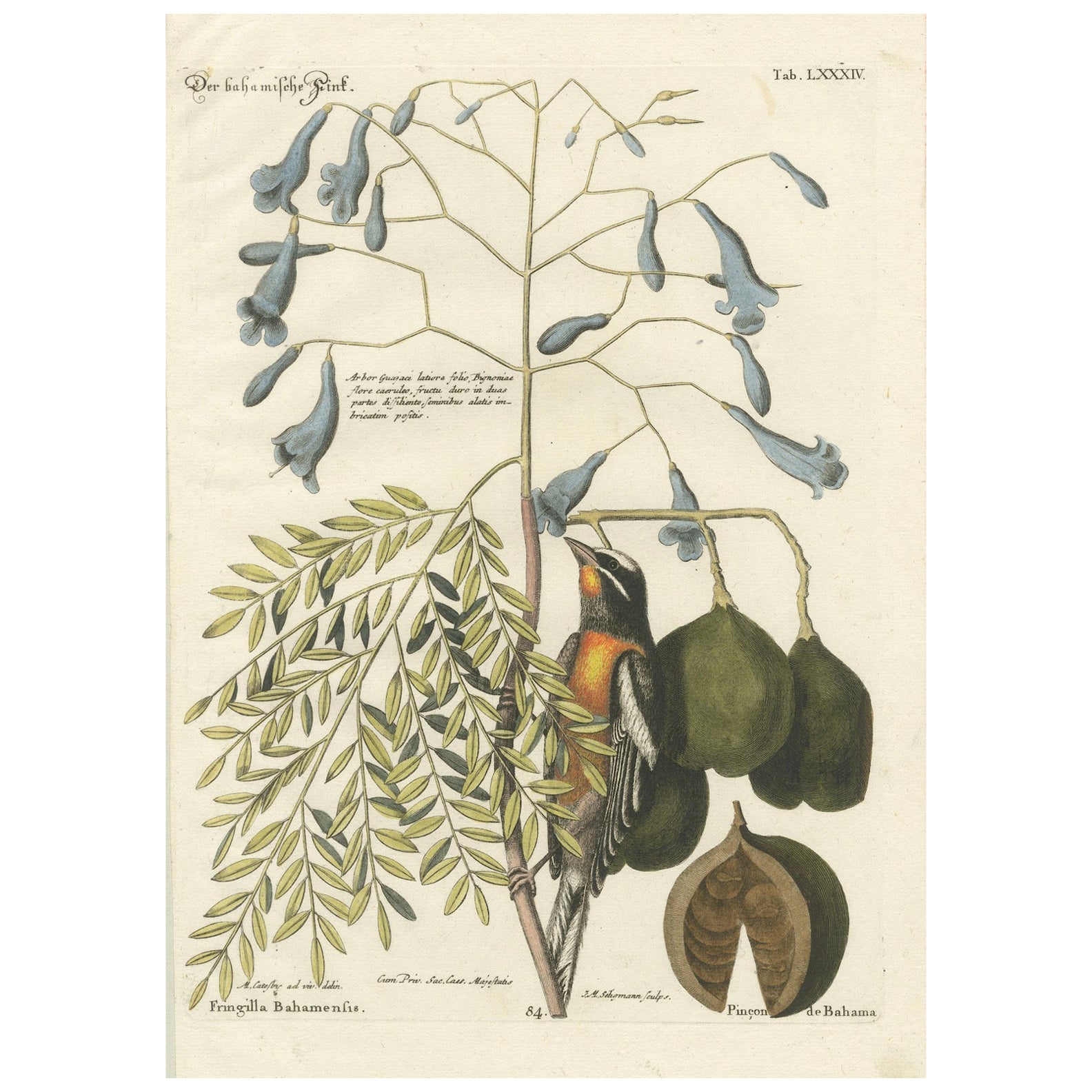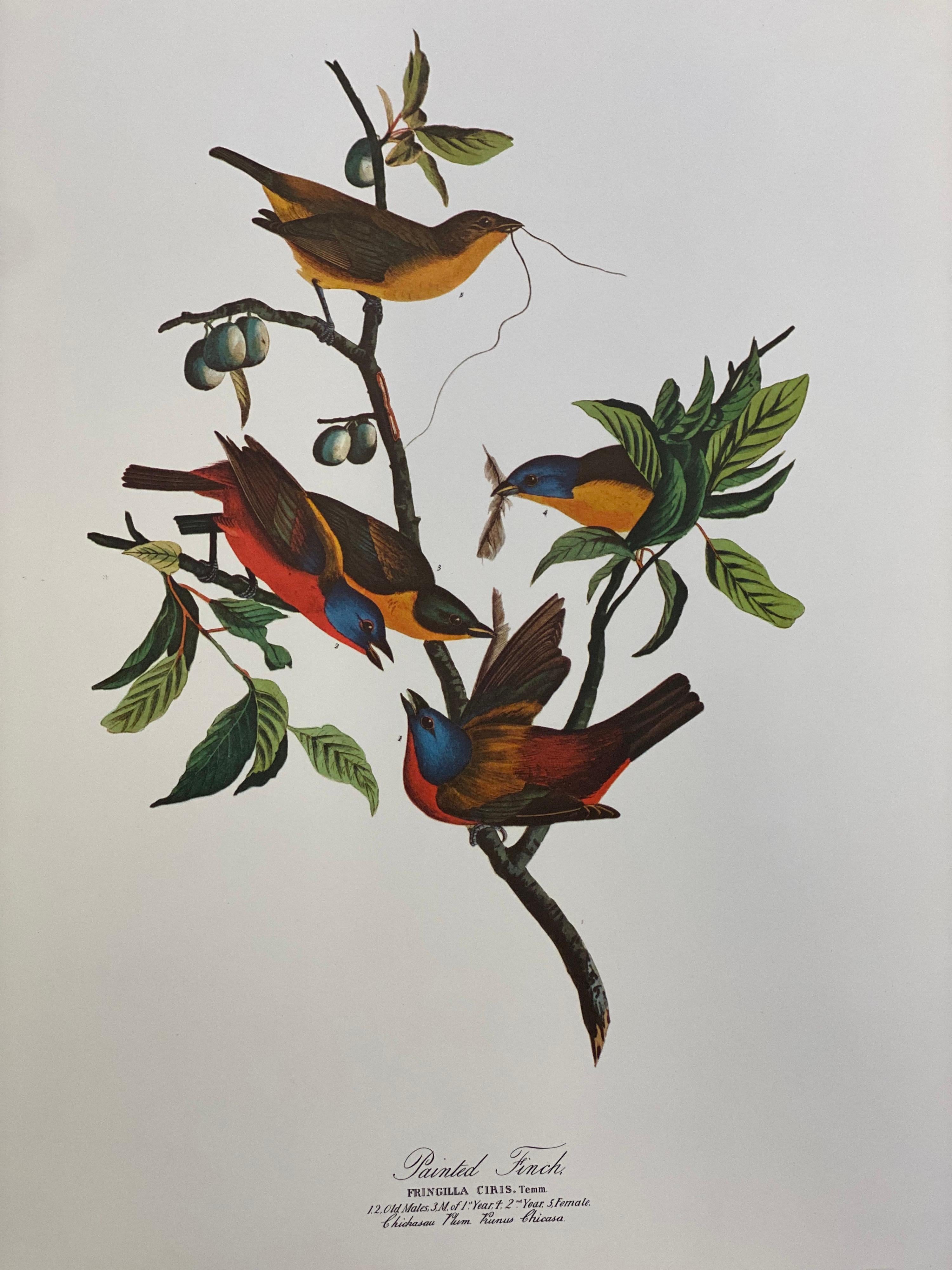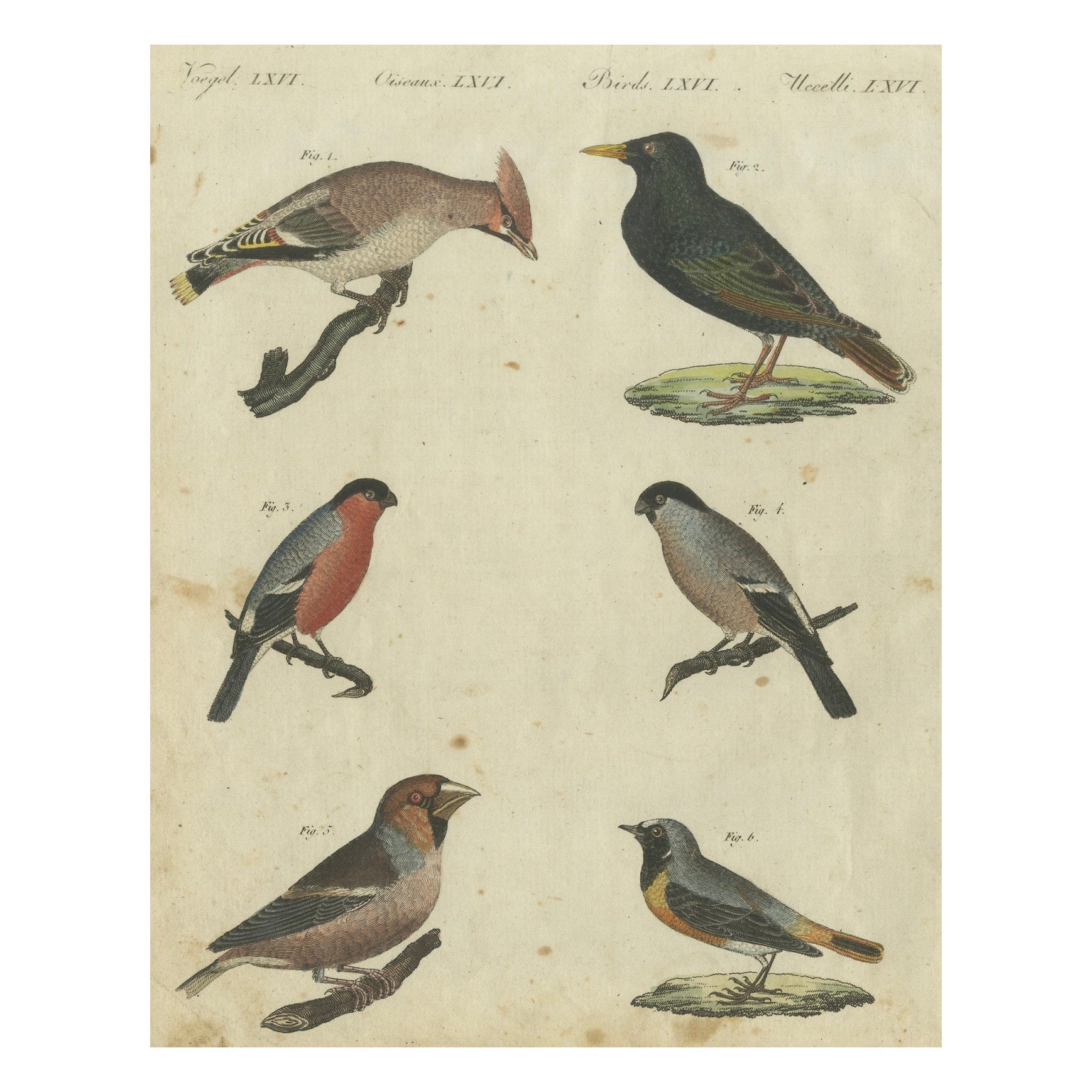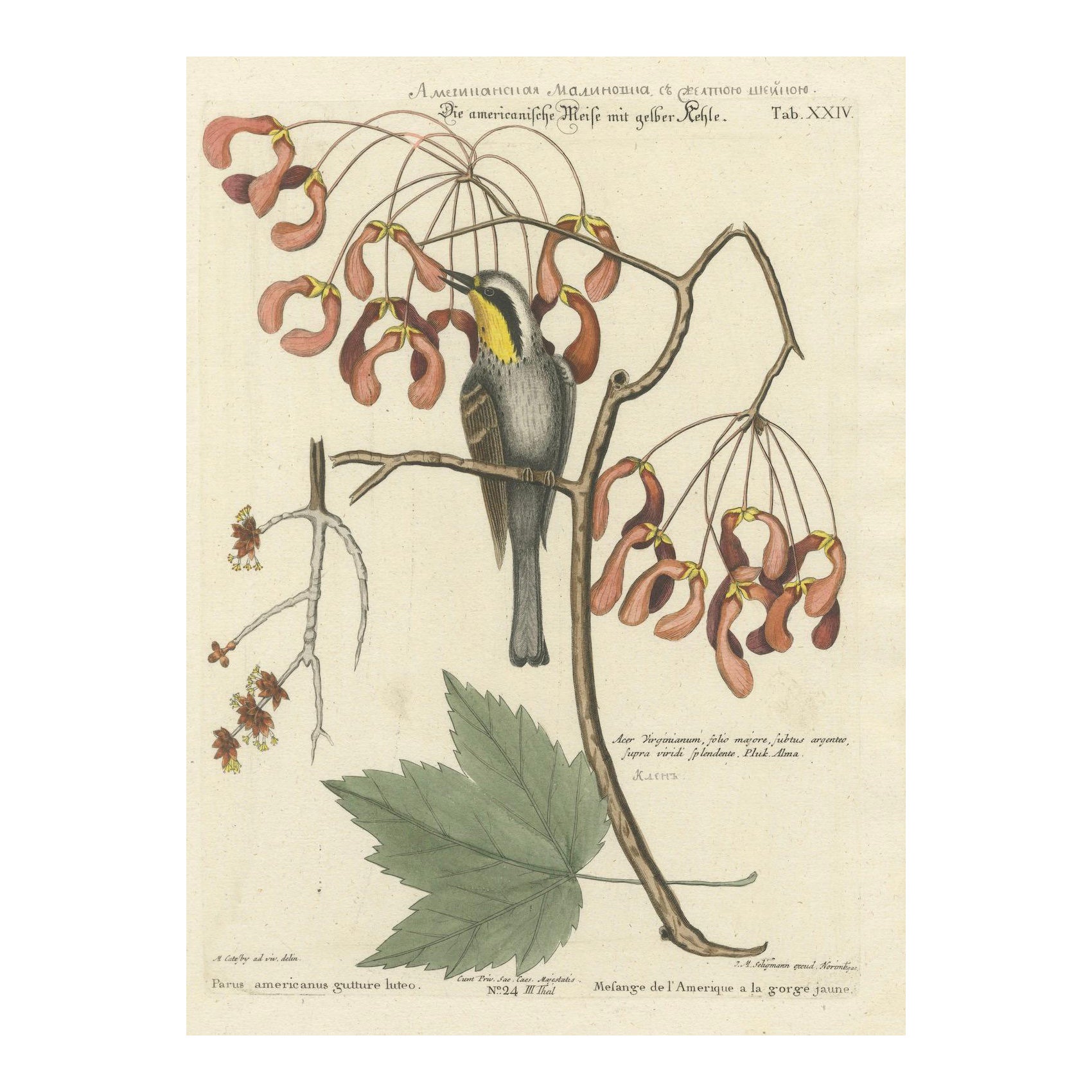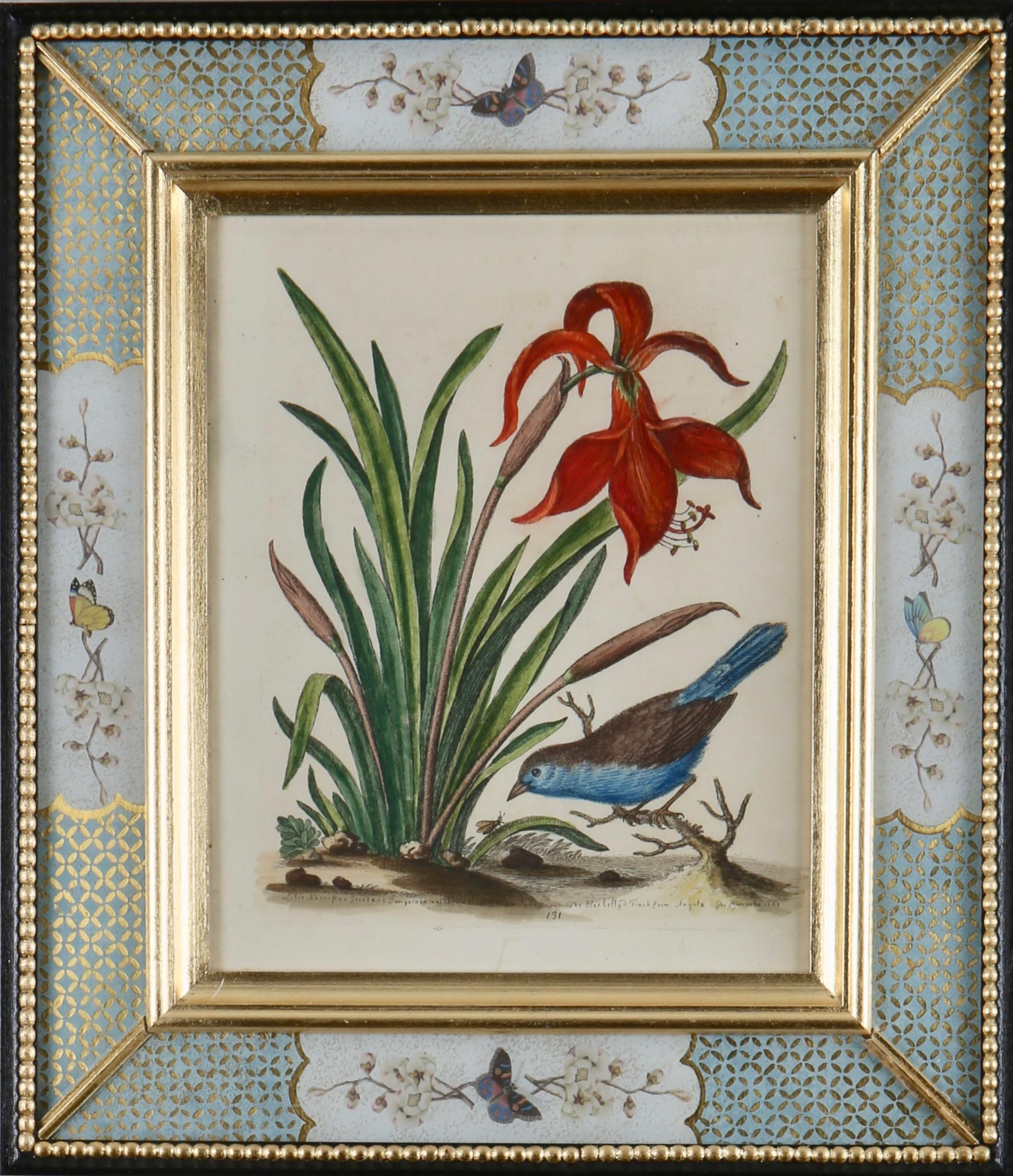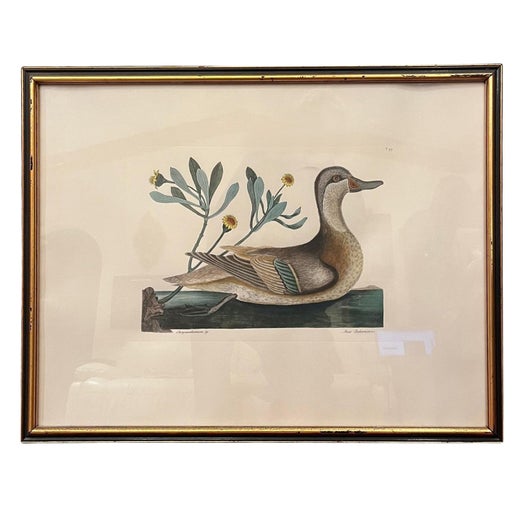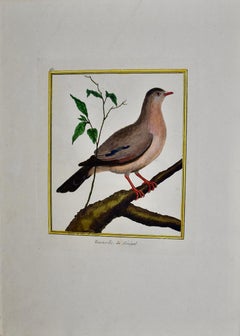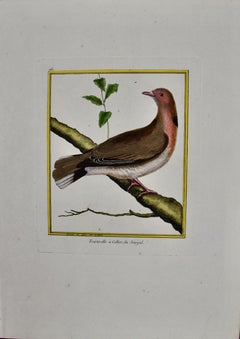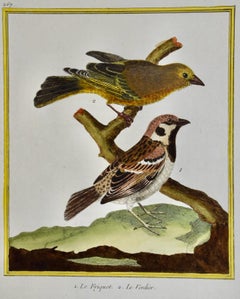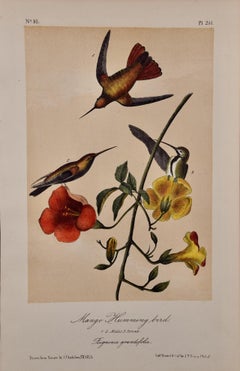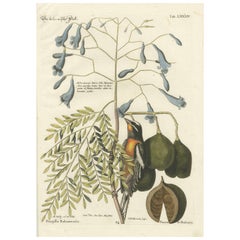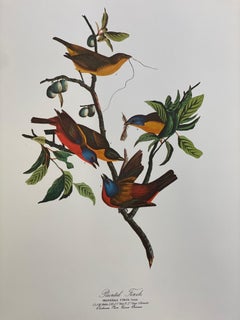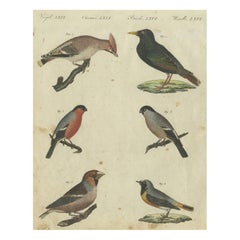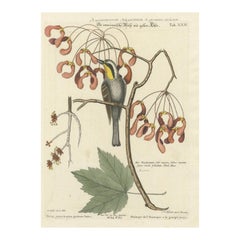Items Similar to 18th Century Catesby Hand-colored Bird & Plant Engraving "The Crested Titmous"
Want more images or videos?
Request additional images or videos from the seller
1 of 9
Mark Catesby18th Century Catesby Hand-colored Bird & Plant Engraving "The Crested Titmous"1731
1731
$2,375
£1,803.09
€2,066.29
CA$3,371
A$3,676.91
CHF 1,931.57
MX$44,483.04
NOK 24,164.61
SEK 22,816.20
DKK 15,423.40
About the Item
A hand-colored copperplate engraving of a bird and plants by Mark Catesby (1683-1749) entitled "The Crested Titmous" from "The Natural History of Carolina, Georgia, Florida and the Bahama Islands", published in 1731. It depicts a small Crested Titmous bird, facing left, perched on the stem of a plant with clusters of mauve colored star-like flowers.
This original Catesby hand-colored engraving, on laid paper with a large central Fleur-de-Lys watermark, is presented in a cream color French mat. The mat measures 20" x 15.5" and the sheet measures 18.75" x 14.75".
Mark Catesby was born in England to a prosperous family, but he traveled to America, first to visit his sister and her husband in 1712. From 1712 to 1719 he explored America observing its birds and plants, taking notes, creating drawings and collecting specimens. He returned to England with this material and created more detailed drawings. His next visit to America 1722-1726 allowed for more detailed research. Upon his return to England he created his monumental and beautiful work "The Natural History of Carolina, Florida, and Bahama Islands", which was published in London in two folio volumes of 11 parts each consisting of 20 plates. It was the first work to depict the flora & fauna of the new world. The illustrations are among the most beautiful and best loved bird and botanical prints of all times. This established the Englishman Mark Catesby as the father of American Ornithology.
- Creator:Mark Catesby (1682 - 1749, English)
- Creation Year:1731
- Dimensions:Height: 20 in (50.8 cm)Width: 15.5 in (39.37 cm)
- Medium:
- Movement & Style:
- Period:
- Condition:Single tiny spot in the left upper corner, otherwise excellent condition.
- Gallery Location:Alamo, CA
- Reference Number:Seller: # 22901stDibs: LU117325503102
Mark Catesby
Mark Catesby (24 March 1683 – 23 December 1749) was an English naturalist. Between 1729 and 1747 Catesby published his Natural History of Carolina, Florida and the Bahama Islands, the first published account of the flora and fauna of North America. It included 220 plates of birds, reptiles, amphibians, fish, insects, mammals and plants. Mark Catesby's The Natural History of Carolina, Florida and the Bahama Islands is generally credited as the first published work to provide illustrations and descriptions of North American flora and fauna. From 1722-1726 Catesby, an English naturalist, ranged over South Carolina, Georgia and the Bahamas sketching and collecting specimens of native plants and animals. Little is known of Catesby's early life. He was born in eastern England in 1683. Although Catesby does not appear to have attended university or studied for the Bar, he was sufficiently educated to write clear English and Latin. His interest in and knowledge of plants may have derived from his uncle, who maintained a botanical garden. Catesby also appears to have benefited from an acquaintance with John Ray, a leading English naturalist of the 17th century and the co-author of an early classic study of birds. It is unclear when or how Catesby developed his skills as an artist. Catesby's first visit to North America occurred in 1712 when he traveled to Williamsburg, Virginia, to live with his sister and her husband, who had settled there. During his seven-year stay, he explored the length of the James River sketching plants and collecting botanical samples. Upon Catesby's return to England in 1719, his work in Virginia drew the attention of several influential members of the Royal Society. And with their financial backing, Catesby returned to North America three years later, arriving in Charleston in May 1722. During his four-year stay, he traveled throughout South Carolina, coastal Georgia and to the Bahamas. The sketches and specimens Catesby gathered during his second North American trip formed the basis for The Natural History of Carolina, Florida and the Bahama Islands. Although most often found as a two-volume set, Catesby's Natural History was published in 11 discrete sections from 1734-1747 and sold by subscription. Although Catesby died in 1749, his work was republished in 1754 and again in 1771. Catesby's work predated the classification system developed by Swedish botanist Carl Linneaus. However, the 1771 edition, featured here, includes a catalog of the Linnean names for the plants and animals Catesby featured in Natural History.
About the Seller
5.0
Gold Seller
Premium sellers maintaining a 4.3+ rating and 24-hour response times
Established in 2011
1stDibs seller since 2019
292 sales on 1stDibs
Typical response time: 1 hour
- ShippingRetrieving quote...Shipping from: Alamo, CA
- Return Policy
Authenticity Guarantee
In the unlikely event there’s an issue with an item’s authenticity, contact us within 1 year for a full refund. DetailsMoney-Back Guarantee
If your item is not as described, is damaged in transit, or does not arrive, contact us within 7 days for a full refund. Details24-Hour Cancellation
You have a 24-hour grace period in which to reconsider your purchase, with no questions asked.Vetted Professional Sellers
Our world-class sellers must adhere to strict standards for service and quality, maintaining the integrity of our listings.Price-Match Guarantee
If you find that a seller listed the same item for a lower price elsewhere, we’ll match it.Trusted Global Delivery
Our best-in-class carrier network provides specialized shipping options worldwide, including custom delivery.More From This Seller
View AllTurtledove: An 18th Century Hand-colored Bird Engraving by Martinet
By François Nicolas Martinet
Located in Alamo, CA
This is a hand-colored engraving of a turtledove entitled "Tourterelle du Senegal (Turtledove of Senegal)" by Francois Nicolas Martinet, plate 160 from 'Histoire Naturelle des Oiseau...
Category
1760s Naturalistic Animal Prints
Materials
Engraving
Turtledove of Senegal: An 18th Century Hand-colored Bird Engraving by Martinet
By François Nicolas Martinet
Located in Alamo, CA
This is a hand-colored engraving of a turtledove entitled "Tourterelle a Collier, du Senegal (Turtledove of Senegal)" by Francois Nicolas Martinet, plate 161 from 'Histoire Naturelle...
Category
1760s Naturalistic Animal Prints
Materials
Engraving
A Greenfinch & A Sparrow: An 18th Century Hand-colored Engraving by Martinet
By François Nicolas Martinet
Located in Alamo, CA
This is a hand-colored engraving of a Greenfinch bird and a tree sparrow ("1, Le Friquet, 2. Le Verdier") by Francois Nicolas Martinet, plate 227 from 'Histoire Naturelle des Oiseaux...
Category
1760s Naturalistic Animal Prints
Materials
Engraving
Mango Hummingbirds: An Original 19th C. Audubon Hand-colored Bird Lithograph
By John James Audubon
Located in Alamo, CA
This is an original John James Audubon hand-colored lithograph entitled "Mango Humming bird, 1. 2. Males. 3. Female. Bignonia grandifolia", No. 51, Plate 251 from Audubon's "Birds of America, lithographed, printed and colored by JT Bowen and published in Philadelphia between 1870-1871. The lithograph depicts an adult male hummingbird, labelled 1, in flight above a beautiful flowering plant, a Chinese Trumpet-vine. Another male, labeled 2, is perched on a flower on the left and a female, labelled 3, is perched on a flower on the right.
This hand-colored Audubon bird octavo-size lithograph sheet measures 10.25" high by 6.75" wide. It is in excellent condition. The original text pages, 185-186, from Audubon's 19th century publication are included.
John James Audubon (1785-1851) was a naturalist and artist. He was initially unsuccessful financially prior to the publication of his famous work “The Birds of America”, spending time in debtor’s prison, once stabbing a disgruntled investor in self-defense. However, his obsession with birds and art motivated him to persist in his goal of documenting every bird in America via his watercolor paintings and publishing his works for all to enjoy. Audubon's first illustrations were published in a large elephant folio size. Due to their expense they were purchased in rather small numbers by the wealthy. To reach a larger audience, Audubon, with the help of his sons and J. T. Bowen, published a smaller octavo sized lithograph version, which were much more affordable.
With the success of his bird projects, Audubon then turned his attention to four-legged animals. He explored the Missouri River in 1843 sketching the four-legged animals he encountered in their natural setting. His expedition covered some of the same regions recently explored by Lewis and Clark, traveling from present day Alaska to Mexico. Audubon realized that this was an opportunity to document these animals in the still relatively pristine American wilderness, before man encroached on their environment.
Between 1845 and 1848, Audubon and his sons John Woodhouse Audubon...
Category
Late 19th Century Naturalistic Animal Prints
Materials
Lithograph
Bird of Prey: An 18th Century Hand-colored Bird Engraving by Martinet
By François Nicolas Martinet
Located in Alamo, CA
This is a hand-colored engraving of a parrot bird entitled "La Bondree (Bird of Prey)" by Francois Nicolas Martinet, plate 420 from 'Histoire Naturelle des Oiseaux' in association wi...
Category
1760s Naturalistic Animal Prints
Materials
Engraving
Swainson's Warbler: A Framed Original Hand-colored Audubon Folio Bird Engraving
By John James Audubon
Located in Alamo, CA
This is an original John James Audubon hand-colored folio sized lithograph entitled "Swainson's Warbler, Male, Sylvicola Swainsonia, Tree: Vulgo, White Oak", No. 10, Plate 50, from A...
Category
Mid-19th Century Naturalistic Animal Prints
Materials
Engraving
You May Also Like
Bahama Finch Engraving by J.M. Seligmann, Hand-Colored Bird Print, 18th century
Located in Langweer, NL
Bahama Finch Engraving by J.M. Seligmann after George Edwards, Hand-Colored, 18th Century
This exquisite 18th-century hand-colored engraving features the Bahama Finch, a vibrant b...
Category
Antique 1770s Prints
Materials
Paper
Large Classical Bird Color Print after John James Audubon - Painted Finch
By After John James Audubon
Located in Cirencester, Gloucestershire
Classical Bird print,
after John James Audubon,
printed by Harry N. Abrams, Publishers, New York
unframed, 17 x 14 inches color print on pap...
Category
20th Century Victorian Animal Prints
Materials
Color
$148 Sale Price
20% Off
Elegant European Birds: 1805 Handcolored Engraving from Bertuch's Masterpiece
Located in Langweer, NL
Handcolored 1805 Engraving of European Birds from Bertuch's "Bilderbuch für Kinder"
This stunning handcolored copperplate engraving from 1805 features six European bird species in...
Category
Antique Early 1800s Prints
Materials
Paper
Engraving of The American Tit Bird with Yellow Throat in Old Handcoloring, 1749
Located in Langweer, NL
The image is an ornate botanical and ornithological illustration from one of Johann Michael Seligmann's collections, which were based on George Edwards's natural history studies.
Th...
Category
Antique 1740s Prints
Materials
Paper
$660 Sale Price
20% Off
Free Shipping
Bird and Beetle - Etching and watercolor (Natural History of Birds, 1741)
By George Edwards
Located in Paris, IDF
George EDWARDS
Bird and beetle ('The Gowry Bird')
Original engraving, enhanced with watercolor
Printed signature in the plate
Dated, 1741
28.8 x 23.3 cm
Created for Volume I of the...
Category
1740s Academic Animal Prints
Materials
Engraving, Watercolor
George Edwards: 18th Century Engravings of Birds
By George Edwards
Located in Richmond, GB
George Edwards: ""A History of Uncommon Birds"", 1749-1761.
A prominent English naturalist and ornithologist, George Edwards (1694 -1773) is best known for his work, ""A Natural His...
Category
18th Century Animal Drawings and Watercolors
Materials
Watercolor, Engraving
More Ways To Browse
18th Century Colored Engraving
Bird Engraving
Antique Bird Engravings
Bird Botanical
Mark Catesby Antique Prints
Catesby Bird Prints
Audubon Folio
Audubon Pelican
Bird Prints Puffin
Blue Dog Tie
British Hunting Prints
Cock Fighting Prints
Colombe Volant
Curly Coated Retriever
Dali Giraffe
Damien Hirst Empress Set
E A Seguy
Exhibition Poster Louvre
